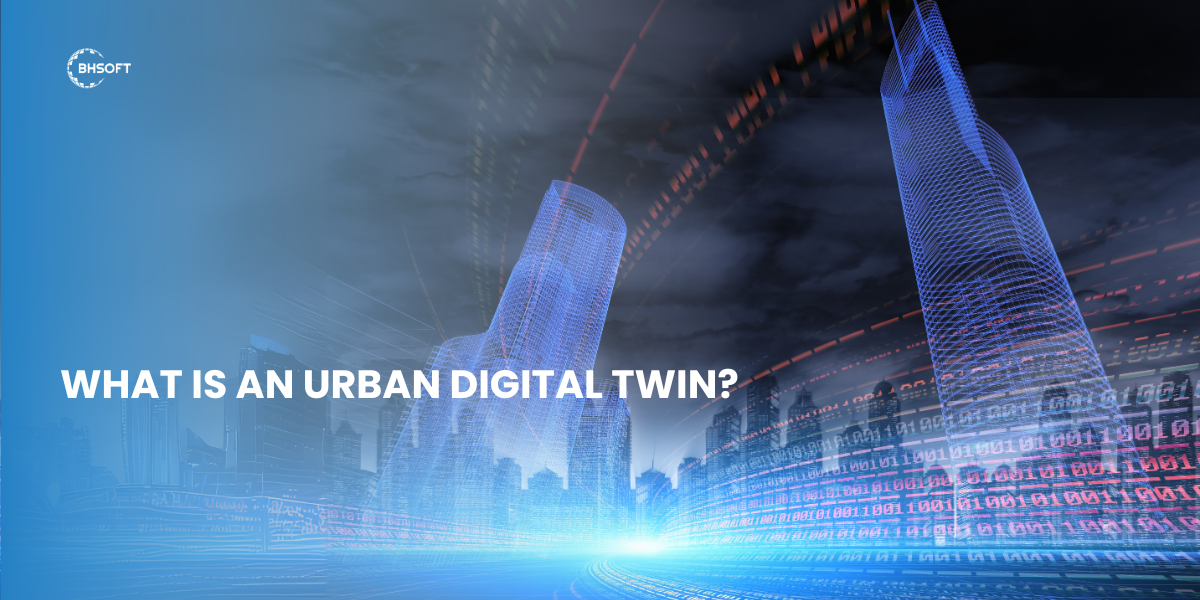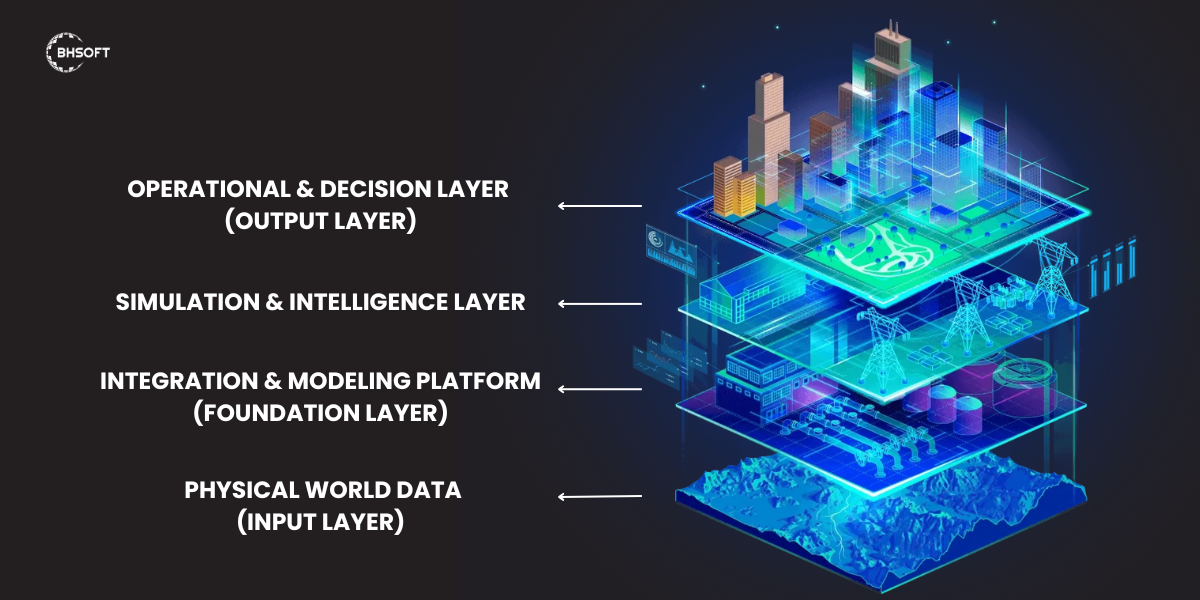Home > Insight > Technology
What Is An Urban Digital Twin?
5 minutes read
Audio description available
May 15, 2025
The term “smart city” has been hyped for years. Smart sensors are great. Real-time dashboards are helpful. But when it comes to understanding how a city actually works, and what might happen if something breaks, you need more than just live data.
You need a model. A system. A second version of the city that runs in parallel.
That’s what an urban digital twin offers: a dynamic, virtual replica of the real world that helps planners simulate traffic, infrastructure, disasters, and development before any real-world change takes place.
In this guide, we’ll unpack what urban digital twins really are, how they work, and why they’re becoming the new backbone of smart city strategy. Let’s dive in!

What Is An Urban Digital Twin?
An urban digital twin is a dynamic, digital replica of a physical city, built using real-time data, mapped in 3D or geospatial systems, and designed to simulate how the city behaves under different conditions.
But it’s more than just a map. A true urban digital twin integrates data from traffic systems, utilities, public services, weather networks, environmental sensors, and even citizen behavior, combining it all into one continuously updated model.
This model allows planners and city operators to run “what if” simulations, such as:
- What happens to traffic flow if we close this bridge?
- How will a new residential tower impact sunlight, wind tunnels, or pedestrian flow?
- What’s the fastest way to deploy emergency services during a flood?
In short, urban digital twins don’t just show what’s happening now. They help predict what’s next and enable smarter, faster decisions.
Cities like Singapore, Helsinki, and Boston are already using digital twins not as experiments, but as everyday planning tools. According to ABI Research, more than 500 cities globally are expected to adopt urban digital twins by 2027, with the market projected to grow from $21 billion in 2024 to $120 billion by 2029.
Learn more: GIS consulting and implementation services
How Urban Digital Twins Work
An urban digital twin isn't just a 3D model. It's an ecosystem built on four key layers:

Data collection from the physical world
Digital twins begin with raw inputs — live data from:
- IoT sensors (traffic, air quality, noise, utilities)
- Smart infrastructure (HVAC, energy grids, mobility systems)
- City services (transit networks, emergency systems, waste management)
- External sources (satellite imagery, weather APIs, mobile usage patterns)
The more data, the more accurate and context-rich the model.
Platform integration and modeling
Collected data is processed and mapped within a cloud-based system. GIS layers, 3D models, and structured databases are fused into a unified platform. Platforms like Azure Digital Twins and TwinWorX use semantic ontologies (e.g., RealEstateCore for buildings or NGSI-LD for city services) to structure entities and relationships.
This allows the system to recognize a "sensor" not just as a device, but as part of a room on a floor, within a hospital context, which makes AI interpretation more powerful.
Simulation and scenario testing
Planners can simulate infrastructure upgrades, energy usage patterns, evacuation scenarios, or zoning changes. Using AI, machine learning, and predictive modeling, these simulations help cities plan proactively.
In Helsinki, for example, a digital twin of the Kalasatama district helped reduce energy usage in buildings by 15%, thanks to optimized HVAC scheduling.
Real-time control and feedback
Advanced systems don’t stop at simulation. They enable live monitoring and even automated control. For example, if an HVAC unit is running inefficiently, the twin can detect the anomaly, alert the operator, or in AI-enhanced systems like TwinWorX, autonomously adjust controls based on machine learning models.
Why Urban Digital Twins Matter: Key Benefits for Modern Cities
Digital twins are delivering measurable results in real cities. Here’s how:
Smarter, faster planning
Simulation reduces guesswork and political gridlock. According to Deloitte, cities using digital twins in planning see 25% faster project approvals and higher stakeholder alignment.
Reduced infrastructure risk
Predictive maintenance based on live data helps cities repair before failure. Public sector use cases have shown cost savings of 10–30% by replacing emergency fixes with planned maintenance.
More sustainable cities
Digital twins support emissions tracking, energy optimization, and scenario modeling. The World Economic Forum calls them a "core enabler of decarbonization" in cities.
For example, cities are using digital twins to optimize street lighting, balance electric grid loads, and simulate green building retrofits, all before implementation.
Emergency readiness
By modeling natural disasters, fire spread, or mass transit rerouting, cities can rehearse high-stakes responses. Boston’s digital twin has been used to model flood scenarios across downtown districts, improving evacuation plans and reducing response times.
Unified operations
Digital twins provide a single pane of glass for all departments. In platforms like TwinWorX, planners, engineers, and operators can interact with a shared 3D view, reducing silos and improving speed of decision-making.
Challenges & Limitations Of Urban Digital Twins
Urban digital twins are powerful, but they aren’t a silver bullet. As cities move toward more connected, data-driven infrastructure, several real-world barriers still stand in the way, from legacy systems to governance issues.
Here’s what often complicates adoption:
Fragmented data and legacy systems
Many cities operate on aging infrastructure and siloed platforms. Data is often incomplete, inconsistent, or trapped in departmental systems that don’t communicate.
Digital twins depend on integration, and when that integration fails, the entire model loses accuracy and usefulness.
Privacy and data ethics
To reflect real-time behavior, urban digital twins collect large volumes of data, sometimes involving people’s movement, utilities, or public services. Without clear boundaries around data usage, consent, and governance, the risks of misuse or surveillance increase.
This makes privacy policy, anonymization, and transparency non-negotiable.
High upfront costs
Creating a functional digital twin of a city involves more than just software. You need sensors, data infrastructure, skilled personnel, 3D modeling, and ongoing system maintenance.
While many cities will see long-term ROI, the initial investment can be hard to justify, especially in municipalities with tight budgets or shifting leadership priorities.
Interoperability and vendor lock-in
There’s no universal framework for building digital twins. Tools, platforms, and data models vary widely across vendors. That makes it harder to integrate systems or switch providers later without starting over.
Open data standards are emerging, but most cities still operate in fragmented ecosystems.
Skills gaps inside city teams
Many municipal departments aren’t staffed with data engineers, simulation specialists, or systems architects. Even when the technology is in place, it’s common for teams to underutilize it, simply because they don’t know how to extract insights or manage updates.
Without a strong internal team or long-term partner, the digital twin risks becoming a passive dashboard instead of an active planning tool.
Conclusion
Urban digital twins are no longer futuristic ideas. They are the backbone of intelligent infrastructure, enabling real-time insight, proactive planning, and autonomous response.
As over 65% of the global population is expected to live in cities by 2050, urban systems will only get more complex. Digital twins help tame that complexity by connecting the physical world to intelligent, responsive models that improve how cities work for everyone.
Cities like Singapore, Helsinki, and Boston aren’t waiting for perfect conditions. They’re building the future now, one simulation at a time.
Ready to bring your city into the twin age?
At BHSOFT, we help governments and technology partners design, deploy, and scale digital twin platforms that work from real-time data integration to predictive simulation and AI optimization.
Explore our Smart City Solutions

